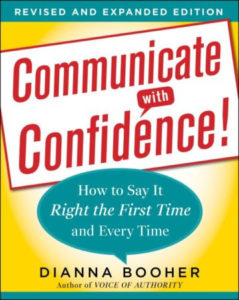


(Forbes first published my article here.)
Distrust represents the biggest barrier between leaders and followers. And that distrust reveals itself in insincere communication. People forgive a lot of quirks in their leaders and coworkers just to keep the workplace civil and projects humming. But insincerity particularly grates on the nerves. As cotton candy fails to satisfy real hunger, insincere or clichéd communication fails to build trust or inspire loyalty.
What communication habits sound insincere? How can you better inspire, encourage, and build stronger relationships with your team?
Here’s a starter list:
You meet someone in the hallway. A typical exchange:
They: “Hi, how are you?”
You: “Fine. And you?”
They: “Good, thanks.”
Although there’s certainly nothing wrong with such an exchange, it’s not exactly inspiring. Instead, it sounds robotic, unthinking, impersonal.
After a recent surgery, my husband recuperated at home for about 3 weeks. Once he got out and about again, people greeted him with, “Hey, how are you?” He’d typically respond with, “About 75-80 percent.” The greeter would invariably chuckle and respond with something original, like: “Really? 75 percent? That must mean by next Monday, you’ll be about 87 percent?”
An original conversation typically followed, and they connected on a more personal level.
Of course, you may not want to have a conversation every time you greet someone. But an original comment (Hey, Charlie—How was your commute this morning?) communicates to others that you’re seeing them as individuals.
You know a pat response when you hear one. In a meeting, you bring up a difficult or sensitive issue your team wants to avoid, and someone says, “Well, I’m sure you guys will figure it out at some point.”
Or let’s say that you pass along a new idea to your manager about a process you think could increase productivity. Your boss responds, “We always appreciate good ideas.” After that platitude, do you walk away feeling heard?”
Or maybe you’re expressing anxiety to a colleague about your upcoming client presentation. Never looking up from her keyboard, the coworker offers this reassurance: “I’m sure you’ll do fine.” Does your anxiety suddenly disappear?
Such rote responses communicate, “I don’t have time to (or want to) focus on your situation.”
Consider this more meaningful comment: “If you’re really concerned about your presentation, you may want to talk to Ken. He briefed that client two weeks ago. He may have some insights for you.”
Again, a deeper connection and helpfulness.
I’ve had far too many of these conversations at a trade-show:
Me: “Can you please tell me if you offer this course in Chicago? And would it be appropriate for my first-line supervisors?”
Agent: “Just give me your card and we’ll add you to the list.”
Such conversations remind me of TV interviews by satellite when the connection is weak. When the host asks a question and the guest has a malfunctioning earpiece, the response is often unrelated.
When that oddity happens via satellite, it’s a tech problem. When it happens in real life, it’s a listening problem.
A sincere compliment should be specific. By its definition, flattery is excessive, exaggerated, and beneficial primarily to the one who gives it (sycophancy). Here’s a good test of how your praise sounds to the recipient: Does the person seem pleased or uncomfortable with your comment?
I recall someone saying to me once during a 3-day retreat: “You have the saddest smile today. Are you unhappy about what the group plans to do?” Immediately, I became aware that, yes, I was wearing my plastic smile during that meeting because I disagreed with the group’s direction.
Insincerity may show up in a generic smile flashed the same way to everyone.
“If I can help in any way, please let me know” is the most frequent offer with the least heart. It communicates, “I’ve given no thought as to how I might help. But I want to look and feel concerned and benevolent.”
If you sincerely want to help, offer what you’re willing to do. If you don’t know what you can do to help, mention some options and let the other person select.
Sincere communication connects others at a deeper level, builds trust for the long-term, and inspires the best in people.
Learn more ways to inspire loyalty through communication with Communicate With Confidence!: How to Say It Right the First Time and Every Time.
